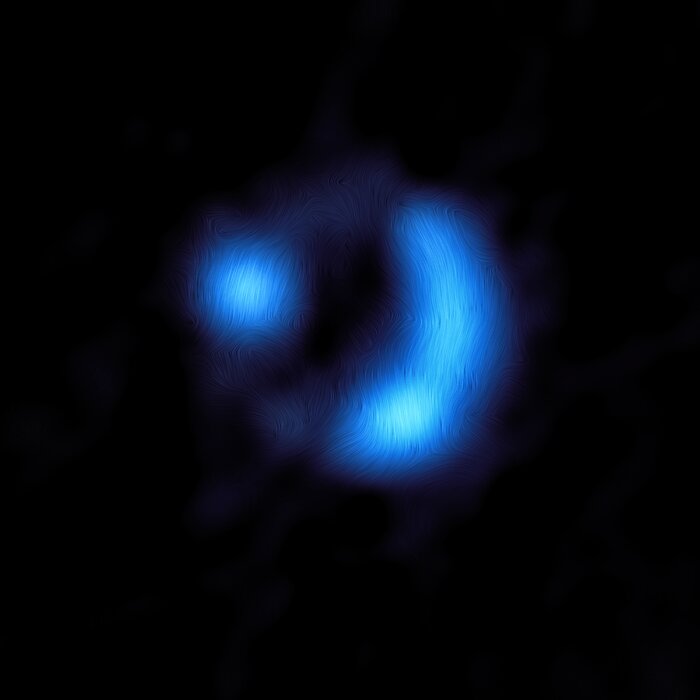ALMA view of the 9io9 galaxy
This image shows the orientation of the magnetic field in the distant 9io9 galaxy, seen here when the Universe was only 20% of its current age — the furthest ever detection of a galaxy’s magnetic field. The observations were done with the Atacama Large Millimeter/submillimeter Array (ALMA), in which ESO is a partner. Dust grains within 9io9 are somewhat aligned with the galaxy’s magnetic field, and due to this they emit polarised light, meaning that light waves oscillate along a preferred direction rather than randomly. ALMA detected this polarisation signal, from which astronomers could work out the orientation of the magnetic field, shown here as curved lines overlaid on the ALMA image.
The polarised light signal emitted by the magnetically aligned dust in 9io9 was extremely faint, representing just one percent of the total brightness of the galaxy, so astronomers used a clever trick of nature to help them obtain this result. The team was helped by the fact that 9io9, although very distant from us, had been magnified via a process known as gravitational lensing. This occurs when light from a distant galaxy, in this case 9io9, appears brighter and distorted as it is bent by the gravity of a very large object in the foreground.
Kredit:ALMA (ESO/NAOJ/NRAO)/J. Geach et al.
O snímku
| Id: | eso2316a |
| Typ: | Pozorování |
| Datum zveřejnění: | 6. září 2023 17:00 |
| Související články: | eso2316 |
| Velikost: | 6336 x 6336 px |
O objektu
| Jméno: | 9io9, 9Spitch, SDSS J020941.27+001558.4 |
| Typ: | Early Universe : Galaxy |
| Vzdálenost: | z=2.6 (rudý posuv) |
| Constellation: | Cetus |
| Kategorie: | Cosmology Galaxies |
Image Formats
Souřadnice
| Position (RA): | 2 9 41.23 |
| Position (Dec): | 0° 15' 57.79" |
| Field of view: | 0.26 x 0.26 arcminutes |
| Orientace: | Sever je -0.0° levá od svislé osy |
Barvy & filtry
| Pásmo | Vlnová délka | Dalekohled |
|---|---|---|
| Milimetrový 242GHz | 1.2 mm | Atacama Large Millimeter/submillimeter Array Band 6 |

